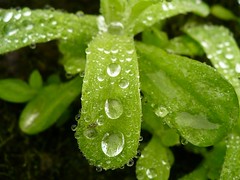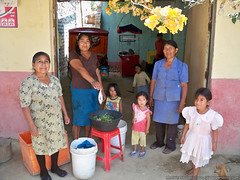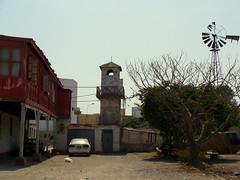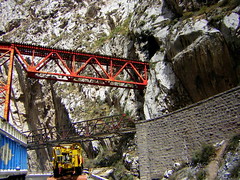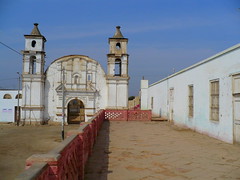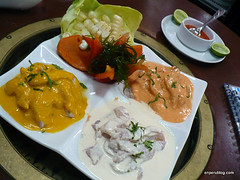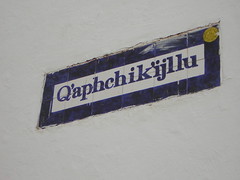In the centre of Miraflores in the city of Lima resides a large mound of dry mud that rises above the surrounding buildings. Close to the rising mountains of the Andes such a thing doesn’t seem entirely out of place – until you look closer. Those are bricks… terraces… stairs. Could it be that this formation is man-made?
Category: "History"
Perro Peruano
The Peruvian hairless dog is a breed native to Peru and was known to be kept and prized by the Incas and pre-Incan coastal cultures. The indigenous believed they were special, somewhat spiritual beings, with powers to heal those in contact with them. This belief still exists to this day, along with many other strange Peruvian superstitions, and people are eager to own these rare, expensive dogs. These myths helped keep the species alive in small towns during and after the Spanish conquest.
Puno’s great party: Virgen de la Candelaria
They say that only the carnival in Rio-Brasil and the carnival in Oruco-Bolivia compare to this, the biggest party in Peru in the city with the most traditional dances in the world – Puno.
El Comercio
El Comercio is the oldest surviving newspaper in Peru. It was founded in 1839 and its circulation is about 120,000.
The centre-right newspaper is said to be the most respected of the Peruvian newspapers and has had a long history to make it so. Independence and Truth was its motto through the late 1800’s and until challenged by the military Government of left-leaning Juan Velasco Alvarado who seized the newspaper, and the country, in the 1970s. Independence and Truth were put on hold as Velasco persecuted dissidents and political enemies. When the democratic Government re-took power after an economic collapse, the paper was given back to its private owners as its first act.
Ecuador: Ingapirca
The Cañaris, a strong and proud people, didn’t want to submit to the Incas, as many other civilisations had done when the empire was being expanded into what is now Chile/Argentina and Ecuador/Colombia.
When the Inca armies finally did bring the Cañaris and other peoples from what is now Ecuador under their control they incorporated their cities and religious centres into their own. This is what happened to the formally Cañari ruins at Ingapirca, the heart of Cañari territory.
Superstitious New Year
Peru has dozens of superstitions that are believed unquestionably – the most colourful being at the ones to bring luck, health and money in the new year.
Lima’s Old City Walls
As part of the restoration work of recent years a section of the southern river bank of the Rimac, where the railway to Huancayo runs, was turned into a small park with fountains for people to come and walk through. During this work the forgotten colonial walls of Lima were rediscovered and preserved as an attraction within the small park.
Ex-President Toledo Charged
It’s been a couple of years since the allegations that ex-President Alejandro Toledo (who I briefly bumped into at Las Palmas air force base) was involved in falsifying signatures necessary to register his Peru Posible party for the 2000 elections. From the day he left office there has been momentum building (initiated by the new Government) to charge and try him for these allegations that he calls an act of political persecution.
Panetón – A Brief History
The Panetón is a cake of Italian origin that became popular in South America through Italian immigration. It is eaten in across the continent all year round, but more so in the festive season. It looks like a giant cup-cake, is very soft and airy and contains a number of pieces of dried fruit.
A Brief History of the Shining Path
Through following the Marxist “shining path to revolution” their aim was to overthrow the bourgeois Government and its institutions – police, army, courts. They would replace these with a communist peasant-revolutionary system based on anarchy.
They were formed in the 60’s by Abimael Guzmán, a university teacher, and began spreading their message through universities and various school councils, before forming militias in the late 1970’s, starting in Ayacucho.
Ollantaytambo – Inca Ruins
The Spanish had caused the Inca empire to collapse. The pacific coast was theirs, they had founded the city of Lima. Marching on Cuzco they entered without a fight. The Inca emperor had been put to death, and the city of Cuzco was pillaged. The Spanish had installed a puppet emperor who was to do their bidding while they looted the empire for gold and forced the people into Christianity.
Ollantaytambo – An Inca Town
I had wanted to visit the ruins in Ollantaytambo since I had seen a documentary several years ago that mentioned it was a place in which a battle between the Spanish and the Incas took place – the only battle in which the Incas won and slaughtered the Spanish.
The current town that sits next to the ruins is in fact the same complex. Ollantaytambo still retains the street pattern of the Inca town it was built upon. The current buildings, in the majority, are the actual buildings that stood in the Inca times – only colonialised-up a little.



